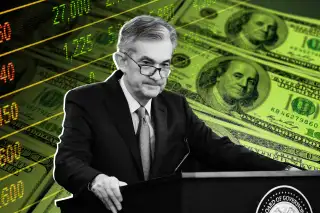What the Fed's Massive New Rate Hike Means for Your Money

The Federal Reserve took its fight against inflation to a new level on Wednesday, announcing that it's raising interest rates by 0.75% — the largest increase the central bank has enacted since 1994.
The target for the federal funds rate, or the rate at which banks lend each other money, is now 1.5% to 1.75%. Although an increase of that size was in line with predictions, it's up from the 0.75%-to-1% range set by the Fed this past May. It also represents a significant shift from the Fed's approach during the height of the pandemic, which was to keep rates near zero in hopes of spurring economic activity.
While that may sound like a bunch of jargon, Fed rate hikes can actually have a meaningful impact on the wallets of everyday Americans, especially amid concerns about rising prices and the possibility of a recession.
Here's what you need to know.
Why did the Fed raise interest rates?
The Fed likes to see inflation low and stable because that allows people and businesses "to make sound decisions regarding saving, borrowing, and investment, which contributes to a well-functioning economy," according to its website. Ideally, that means it wants inflation to average out to about 2% in the long run.
Inflation reached 8.6% in May, hitting a 40-year high for the fourth time this year. The Fed is now attempting to get things under control. The primary way it can do that is to raise the federal funds rate.
Just how big is the Fed's new rate hike?
The 0.75% increase is so big that Fed Chair Jerome Powell said last month that a hike of this size was "not something the committee is actively considering." It's the largest since November 1994.
"We thought that strong action was warranted," Powell added in a Wednesday news conference.
The Fed has raised rates twice this year so far, increasing them by 0.25% in March and 0.5% in May. Experts initially predicted seven rate hikes in 2022, but the specifics are constantly changing because prices keep climbing. (Ongoing issues with the supply chain and the Russia-Ukraine war have complicated the situation and exacerbated inflation, too.)
As the Washington Post reports, the Fed is also grappling with criticism about its reputation. Powell, as well as U.S. Treasury Secretary Janet Yellen, spent months insisting inflation was transitory but recently had to walk back those remarks. It's possible the Fed is taking, and will continue to take, more aggressive action as a result.
"Fed cannot afford to be seen as 'behind the curve' when its inflation-fighting credibility is under question," Andrzej Skiba, head of the BlueBay U.S. fixed income team at RBC Global Asset Management, wrote in an email to reporters.
What does the Fed rate hike mean for me?
When the Fed raises interest rates, it effectively makes borrowing money more expensive. Christopher Jones, chief investment officer at Edelman Financial Engines, told Money in February that variable credit card rates and adjustable-rate mortgages, for example, "tend to be very sensitive" and "ratchet up in lock-step with what the Fed is doing."
We've already seen mortgage rates rise from 3.5% in January, when the Fed started saying it would raise rates this year, to over 6% now.
This also means it's extra important to make sure you're not carrying a balance from month to month on your credit card, and if you are, you may want to put it on the card with the lowest annual percentage rate, or APR.
Investors should be prepared for some more market volatility in reaction to the Fed news too. But as far as investment strategy goes, the best plan of action is likely to stay the course. Charles Schwab's Rob Williams told Money recently that "we don't think people should make major changes" — as long as they have a diversified portfolio and keep their focus on the long term.
More from Money:
How Powerful Is Fed Chair Jerome Powell, Really?
From Eggs to Airfare, Blame High Inflation for These 5 Items Skyrocketing in Price